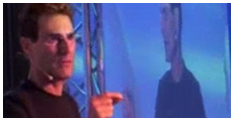Chapter 21
Human levitation
We have seen that some psychics are able to slide objects about on a surface without the use of touch. I have not seen, but have heard, reliable reports of the occasions on which Jean-Pierre Girard has held small objects levitated above the table surface for a period of several seconds; this was also reported to be without the use of touch or fraud. We might suppose that a paranormal quasi-force field was operating, such as electromagnetic forces operate in the normal levitation of metal objects above current-carrying coils. If a psychic quasi-force field can act on small objects, why can it not also act on the human body and allow it to levitate?
There have been several reported instances of religious mystics levitating themselves slowly off the ground during prayer; the most famous are St. James of Compostella and St. Joseph of Copertino.(59) The nineteenth-century psychic, Daniel Dunglass Home, was reported by responsible investigators and scientists to have floated about the room and, on 13 December 1868, out of a window and back again.(60) Other reported cases of levitation are those of Sister Maria Vilani, Veronica Giulani St. Bernadino Realino, St. Theresa of Avila, St. Francis of Assisi, Stainton Moses, Florence Cook, Eusapia Palladino, (Not all of these in this list are of equal sanctity, and it will be recalled by students of psychical research that Eusapia Palladino enjoys a particularly poor reputation in the matter of fraudulent phenomena. It appears that what especially disenchanted the British researchers with Eusapia was her conviction of being caught cheating on the croquet field!) Maria Vollhardt, Willi Schneider, Schrenck-Notzing’s 1927 anonymous subject(40) and the Eddy children of Chittenden, Vermont. I have seen an interesting short moving pictures(61) made by a German journalist named Ohlsen portraying the levitation of a West African priest Nana Dwaku above burning coals. Human levitation is one of the ‘siddhis’ or powers supposed to be available to Hindu mystics, and attempts have been made to teach their development in Europe. Photographs of airborne meditators have been widely publicized, but of course still photographs provide much less information than moving pictures. It is believed that in the first stage the subject experiences a violent but slow vibration of the entire body – these are almost muscular twitches; a more advanced subject becomes able to make small leaps from a bodily position in which leaping would normally be impossible – the lotus position, seated cross-legged on the ground. In the final stage, the subject becomes able to levitate his body steadily at will.
Probably the nearest thing to levitation encountered by psychic researchers is the throwing about of human bodies in a poltergeist attack. There are accounts of this in the literature, and in 1977 in England witnesses reported this phenomenon in the Enfield poltergeist case, which is in course of documentation by Maurice Gross and Guy Playfair. There have been instances of sleeping child metal-benders being found on top of wardrobes, etc., complete with bedclothes; climbing would have been just possible, but the presumption, not well proven, is that the bodies were levitated up to their new situation. In 1979 the throwing about was again reported in the Midlands. There is also the possibility of teleportation, and of composite processes of successive teleportations and levitations. One witness at Enfield (Mr B.) claimed that he was lifted out of his chair and that the feeling was as though a cushion of air, not a draught, pushed him upwards. There was also a twisting motion, which rotated him almost half a turn in the process. I can only conjecture at this stage, but I think it at least reasonably likely that in some poltergeist cases bodies have been thrown about.
In British schools ‘levitation games’ are sometimes played by children. A ritual is occasionally followed (e.g. running round and round a seated or lying child and chanting, ‘He is ill; he is dead’ etc.); after the ritual a number of children attempt to raise the body, each placing one or two fingers underneath it. The game starts with many children, who find the task easy, using only normal forces. The number is reduced one by one, and the continuing ease might suggest a paranormal contribution. The unexpected success has sometimes caused worried teachers to forbid the continuance of the game. I have found many children who insist that the body suddenly seems to lose weight.
But occasionally the lifters press their hands downwards before the lift, and the relaxation of this muscular tension makes the lifting seem easier than it would otherwise be. If we are looking for a paranormal rather than a physiological effect, then obviously this pressing of hands should be avoided.
I have been impressed by taking part myself in the lifting of fifteen-year-old Gill Costin by Kim Griffiths and her schoolfriends. Gill makes her body go rigid, and it certainly takes an effort. to get her off the ground. But when she is off the ground she sometimes appears to become lighter. Sometimes her raised body glides forwards or sideways, and the lifters have difficulty in preventing this. Naturally the idea comes to mind that one or more of the lifters are pulling or pushing her horizontally. All the lifters deny this, and changes in arrangement of the lifters make no difference.
This children’s game is sufficiently strange to be worth further investigation with the aid of instruments, the lifters standing on a chart-recording weighing machine.
One of the metal-bending children, Willie G., has told me that he was able to levitate himself, but only when quite alone in his bedroom. I asked him to levitate up to his bedroom ceiling and write and put his inked fingerprints on it; he was also able to carry a Polaroid camera up with him, to photograph himself in proximity to the ceiling. All these tasks were done successfully, but of course do not represent good validation. Willie’s reported levitation still remained a very private activity, and it would not take place when other members of the family were in the room, let alone myself. Since Willie’s home was far away, but his father often visited London, I decided to video-tape Willie in my laboratory.
I attempted to instrument possible apparent weight loss when Willie was lying on his back on a special mattress. If he was unable to reach either the floor or any furniture, then weight could be lost either by jumping up off the instrumented mattress – a rapid loss or by levitation, which might take place with a more gradual weight loss. The instrumentation, similar to that used earlier by Dr King and myself in experiments with Graham P., consisted of an inflatable rubberized mattress connected to a recording differential capacitance manometer. On the mattress was placed a wooden board, and initially the mattress was connected by rubber and glass tubing to both arms of the differential manometer. After Willie had taken up his position flat on his back or kneeling on the board, a stopcock in one arm of the tubing was closed, so that the reference pressure in that arm of the differential manometer was now fixed. Any change of pressure in the mattress, due to a change in weight compressing it, could be recorded.
Pressure changes also arise from:
(a) differential temperature changes, by transmission of body heat, by cooling after the heating of the gas during inflation, or the heating due to actual compression;
(b) real or virtual leaks in the system;
(c) mechanical relaxation process in the material of the rubber mattress;
(d) shifts in position of the subject on the board.
The first three causes can readily be studied in independent experiments, and the typical instrumental drifts on the chart-recorder analysed. The fourth factor cannot of course yield long-term pressure changes, but provides plenty of noise of short time constant, as the rubber and the air readjust themselves to the movement of the subject on the board. When the subject shifts his position there is no permanent deflection but, rather, a pulse of about one second duration, usually followed by ringing. A continual violent wriggling or writhing yields a chart-record such as that shown in Figure 21.1b.
In experimental sessions with Willie the results were negative; not only did he fail to get off the ground, but even the chart records failed to show really unambiguous weight losses; all the signals which were recorded could possibly have been attributed to other causes. Moreover the absence of videocamera left me unsatisfied.
I have more recently had the opportunity of getting to know how human levitation is approached by parapsychologists in the Soviet Union; it is known as ‘partial death’, a term which indicates a rather different conceptual approach. In 1977 a young Russian physicist, Auguste Stern, defected to the West and related some of his experiences in parapsychology. He had worked in the Siberian science city of Novosibirsk, at the Institute for Automation and Electrometry. The parapsychology department of the Institute housed about fifty scientists, but Stern was perturbed about the intended use of the hypnotism techniques on which they were working for ‘mind control’. In previous years he had himself participated, he claims successfully, in ‘partial death’ experiments, being himself able to produce effects.
According to Stern, the technique used in the Soviet Union to induce human levitation is to enclose the prone subject within a cube of mirrors. The multiple images, apparently stretching in all directions to infinity, have the effect of disorientating the subject, who then levitates if he has the ability.
During the summer of 1977, mirrors were set up for Stern by film producer Alan Neuman,(30) who wished to record this phenomenon. I placed my mattress equipment inside, with the necessary rubber tubing leading out through a corner. Dr Stern lay on a large wood-backed mirror which completely covered the mattress; thus he could see nothing but images in mirrors, except for one side wall which was covered with black cloth. The moving picture cameras photographed him through holes in this cloth.
Dr Stern was disappointed that he did not leave the mirror completely. He had not attempted ‘partial death’ for some years and was disturbed by the resilience of my mattress. A film record exists of his squirming motions, which contributed to the noise on the chart records of Figure 21.1e. However, there are inexplicable features in at least two places in the half-hour of recording; these are periods during which a loss of more than a kilogram occurred for several seconds at a time. Such effects could have been produced if the subject had pressed his hands over the edge of his mattress and forced himself up from the floor. But the film record shows that he could not have done this: rather, he squirmed about, shifting his weight to different regions of the mirror. According to Dr Stern, the squirming is not typical of ‘partial death’ sessions, but was produced because he was unused to the insecurity of my rubber mattress support.
Figure 21.1 Chart-records with instrumented rubber mattress. (a) Mattress calibration pulses of 2- and 5-kg weights. (b) Short-lived pulses produced by sitting upright and violently bouncing up and down. (c) Pulses produced by rolling over from the back to the chest. (d) Pulses produced by strongly arching the back, so that only the head and feet touch the board. (e) Part of levitation experiment record.
I have made laboratory tests of the ‘muscular noise’ which is produced by squirming on the mattress. Since rubberized material can expand, the pressure will remain constant only when the areas of contact between mattress and board (and mattress and ground) remain constant. For example, rolling the body over onto one side of the wooden board distorts the mattress, producing pressure changes as shown in Figure 21.1c. Sitting on the wooden board and bouncing up and down produces the artefacts shown in Figure 21.1b, the apparent weight reductions being larger than the 5 kg calibration pulses shown in Figure 21.1a. Arching the back or doing press-ups expends energy in elastic bending of the wooden board, so that a temporary reduction of pressure is found as shown in Figure 21.1d.
My experience of these and similar effects has led to the rejection of nearly all of Dr Stern’s chart record as evidence of paranormal weight loss. But there remain two sets of signals, one of which is reproduced in Figure 21.1e, which when taken in conjunction with the film record are difficult to explain in normal terms. My assessment of them is to take them sufficiently seriously to warrant the planning of further research. The cube of mirrors seems to be a powerful psychological support for the subject, but it is difficult to construct with sufficient attention to safety.
Levitation of furniture and humans might be supposed to take place in various ways, of which I mention only two. First, there is the possibility of a continual rapid series of teleportation events, each to a position very slightly removed from its predecessor; this would produce the appearance of continuous movement or suspension. Second, we would hypothesize a tube of quasi-force reaching from the body to the floor, similar to the ‘cantilever theory’ of table-lifting advanced by Crawford.(24) This careful but little-known experimenter of fifty years ago (Crawford is still remembered by seniors at the Queen’s University, Belfast) found quantitative evidence for the concept of quasi-force in the form of a tube or cantilever stretching from the medium’s body to the table which she was lifting. Additional weight was assumed by the medium’s body whenever the table was lifted without touch. Imprints of the ‘cantilever’ were recorded in wet clay, etc.
It is notable that the concept is somewhat similar to the fibres of Carlos Castaneda’s (probably fictitious) sorcerer Don Juan.(62) At about the same time as Crawford was researching, the Berlin engineer Fritz Grunewald(63) was performing similar experiments with a platform resting on a system of springs, the displacements of which were transmitted by variations in electrical resistance to a recording galvanometer. His results indicated mainly losses rather than gains in weight.


Latest Articles

Motivational Inspirational Speaker
Motivational, inspirational, empowering compelling 'infotainment' which leaves the audience amazed, mesmerized, motivated, enthusiastic, revitalised and with a much improved positive mental attitude, state of mind & self-belief.



















